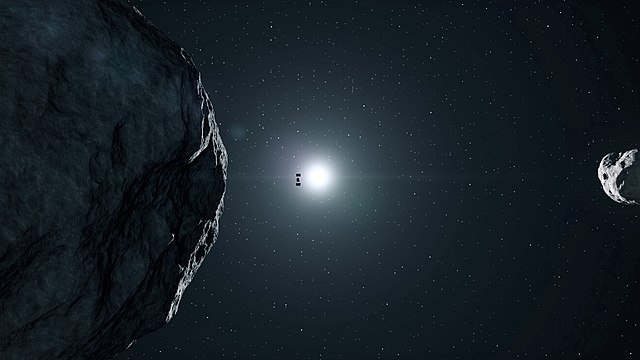The Hera mission
The European Space Agency (ESA) is developing a space vehicle called Hera, planned to launch in October 2024. The Hera mission’s main goal is to learn more about the Didymos binary asteroid system, which consists of the asteroid Didymos and its smaller moon Dimorphos.
The Hera mission is unique because Hera and NASA’s DART spacecraft will have been the first to closely study a binary asteroid system, which makes up about 15% of all known asteroids.
Both missions are part of an international collaboration known as the Asteroid Impact and Deflection Assessment.
The asteroid Didymos made history when NASA’s DART mission intentionally collided with it on September 26, 2022, in an effort to change its orbit.
When Hera arrives at Didymos and Dimorphos in late 2026, it will create detailed maps of Dimorphos, analyze the physical properties of both asteroids, and measure both the crater and the momentum transfer efficiency made by the impact of the DART mission.
In addition to furthering the science of planetary defense, the Hera mission will also augment other technological knowledge, such as the driverless navigation systems that Hera will use to move around the asteroid. The Hera vehicle will also release two smaller spacecraft, Milani and Juventas, to perform unique scientific measurements.
The Hera vehicle
Hera has been characterized as the self-driving car of space missions. Designed over the past 20 years through multiple asteroid mission studies, Hera is an advanced spacecraft for exploring deep space. Unlike the van-sized, 3-ton Rosetta spacecraft that chased comets, Hera is much smaller: roughly the size of a large desk and weighing about 350 kg. When fully fueled, it weighs 870 kg. Hera is powered by solar panels and uses hydrazine as its fuel.
What makes Hera unique among space probes is that it can figure out where it is and where it’s going. Hera’s guidance, navigation, and control tasks are made possible by taking information from different sensors and combining them–a process known as data fusion–to provide accurate data about its environment in space. For example, Hera’s navigation uses visual tracking to identify special features on an asteroid’s surface, measurements from lidar altimeters for altitude, and its onboard inertial sensors and star trackers. These different types of data come together to give Hera a complete view of what’s around it.
Image credit: Hera in orbit.jpg., ESA/Science office, https://commons.wikimedia.org/wiki/File:Hera_in_orbit.jpg#/media/File:Hera_in_orbit.jpg

+ There are no comments
Add yours